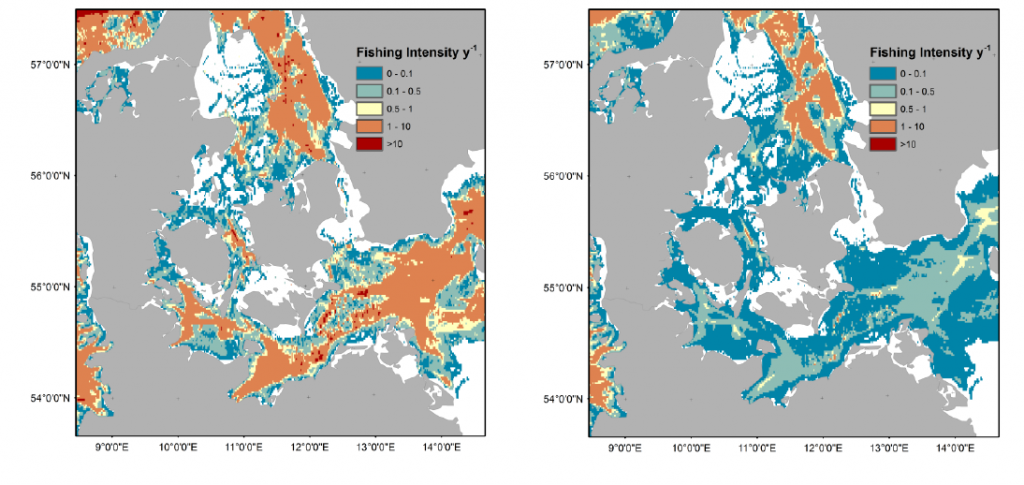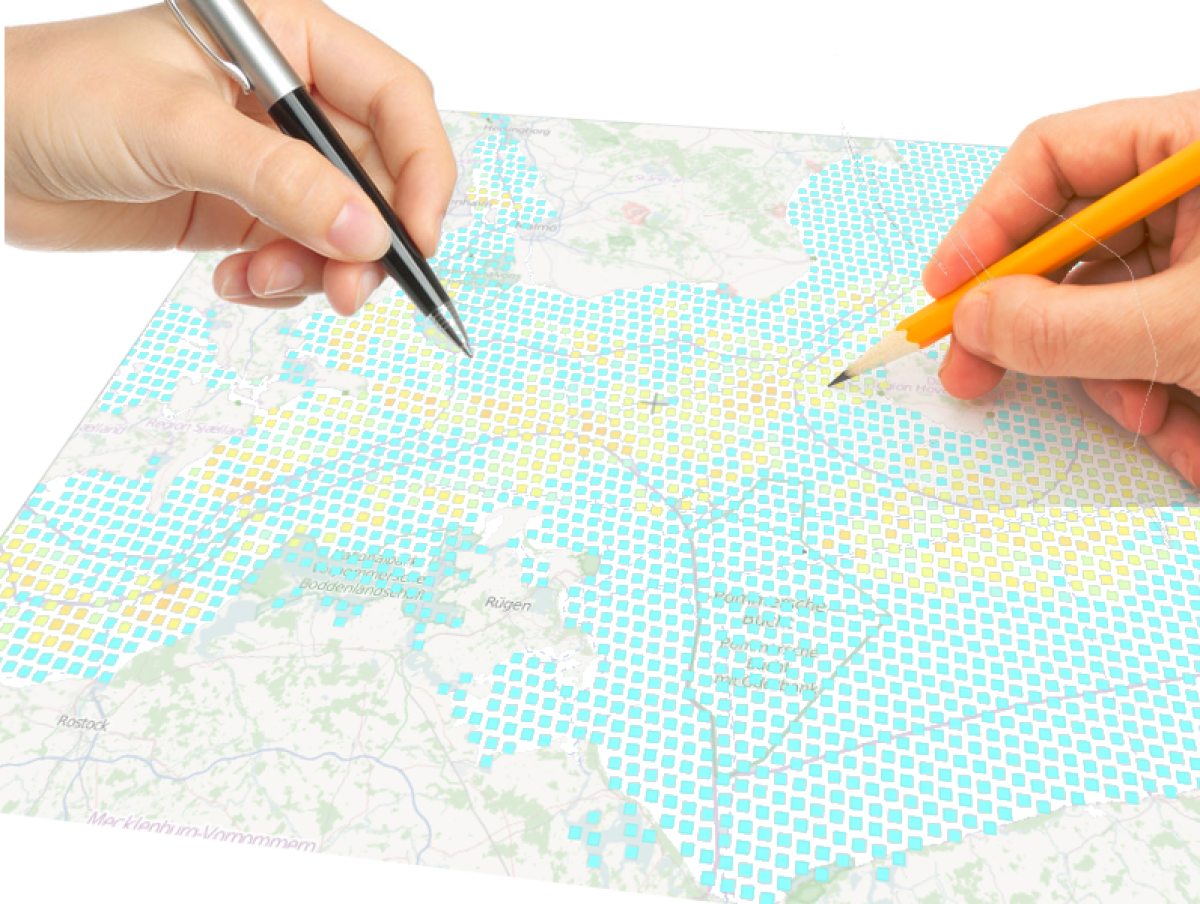Multi-sectoral and multi-disciplinary marine spatial planning methods are prevailing in the EU Marine Strategy Framework Directive. Such integrated marine management needs to consider the commercial fishery and all other sector uses of the sea, such as transport, energy exploitation and recreational use.
Consequently, each of these pressures on the marine ecosystem needs to be mapped.
 Annual average fishing intensity (2010-2012) at the surface level (left; sediment abrasion < 2cm) and subsurface level (right; abrasion ≥ 2 cm) for all bottom contacting gears from Denmark, Sweden and Germany. (Source: here)
Annual average fishing intensity (2010-2012) at the surface level (left; sediment abrasion < 2cm) and subsurface level (right; abrasion ≥ 2 cm) for all bottom contacting gears from Denmark, Sweden and Germany. (Source: here)
Simultaneously, the EU Common Fisheries Policy recently recognized the importance of accounting for heterogeneity in fishing practices from different fleets for managing
commercial fisheries. It was acknowledged that a shift should take place from managing individual fish stocks towards managing fleets, mixed fisheries, and economic issues.
Fine-grained VMS data enable obvious improvements to describe used areas and spatial fishing pressure with higher resolution than the ICES rectangles. Hence, the linkage of VMS with logbooks constitutes very valuable information for mapping the spatiotemporal heterogeneity of landings and economically important fishing grounds to act as the basis for management decisions and designation of priorities areas.
 These maps can be used directly for conditioning the DISPLACE model and inform area-based management performing strategy evaluation and scenario modelling of different management options associated with, for example, the establishment of spatial regulated areas and displacement of fishing effort in relation to ecosystem conditions (sensitive habitats), variability in fish stock occurrence and other uses of the sea.
These maps can be used directly for conditioning the DISPLACE model and inform area-based management performing strategy evaluation and scenario modelling of different management options associated with, for example, the establishment of spatial regulated areas and displacement of fishing effort in relation to ecosystem conditions (sensitive habitats), variability in fish stock occurrence and other uses of the sea.

Francois Bastardie is a DTU-Aqua Senior Scientist and method developer in the Section of Ecosystem-based Marine Management with a Ph.D. in Biological Science. He has been involved in several national and EU Funded projects developing expertise in spatial fisheries and fisheries databases. He has a strong background in modeling fishing and the bio-economic dynamics including developing agent-based models for combining marine ecosystems and natural resource extraction models, fisheries economics in a mixed fisheries perspective. He has an experience of 10 years leading to more than 35 peer-reviewed publications by conducting scientific-based fisheries management evaluation with scenario-testing evaluation and simulations, including fleet dynamics and consequences on the economy of fisheries, population dynamics and fish stock assessment. He was in charge of the evaluation of some of the EU long-term fisheries management plans with consequent participation to ICES and STECF working groups, including giving advise from regional to international policy makers.

Author: Francois Bastardie
Francois Bastardie is a DTU-Aqua Senior Scientist and method developer in the Section of Ecosystem-based Marine Management with a Ph.D. in Biological Science. He has been involved in several national and EU Funded projects developing expertise in spatial fisheries and fisheries databases. He has a strong background in modeling fishing and the bio-economic dynamics including developing agent-based models for combining marine ecosystems and natural resource extraction models, fisheries economics in a mixed fisheries perspective. He has an experience of 10 years leading to more than 35 peer-reviewed publications by conducting scientific-based fisheries management evaluation with scenario-testing evaluation and simulations, including fleet dynamics and consequences on the economy of fisheries, population dynamics and fish stock assessment. He was in charge of the evaluation of some of the EU long-term fisheries management plans with consequent participation to ICES and STECF working groups, including giving advise from regional to international policy makers.
View all posts by Francois Bastardie
 Annual average fishing intensity (2010-2012) at the surface level (left; sediment abrasion < 2cm) and subsurface level (right; abrasion ≥ 2 cm) for all bottom contacting gears from Denmark, Sweden and Germany. (Source: here)
Annual average fishing intensity (2010-2012) at the surface level (left; sediment abrasion < 2cm) and subsurface level (right; abrasion ≥ 2 cm) for all bottom contacting gears from Denmark, Sweden and Germany. (Source: here) These maps can be used directly for conditioning the DISPLACE model and inform area-based management performing strategy evaluation and scenario modelling of different management options associated with, for example, the establishment of spatial regulated areas and displacement of fishing effort in relation to ecosystem conditions (sensitive habitats), variability in fish stock occurrence and other uses of the sea.
These maps can be used directly for conditioning the DISPLACE model and inform area-based management performing strategy evaluation and scenario modelling of different management options associated with, for example, the establishment of spatial regulated areas and displacement of fishing effort in relation to ecosystem conditions (sensitive habitats), variability in fish stock occurrence and other uses of the sea.
